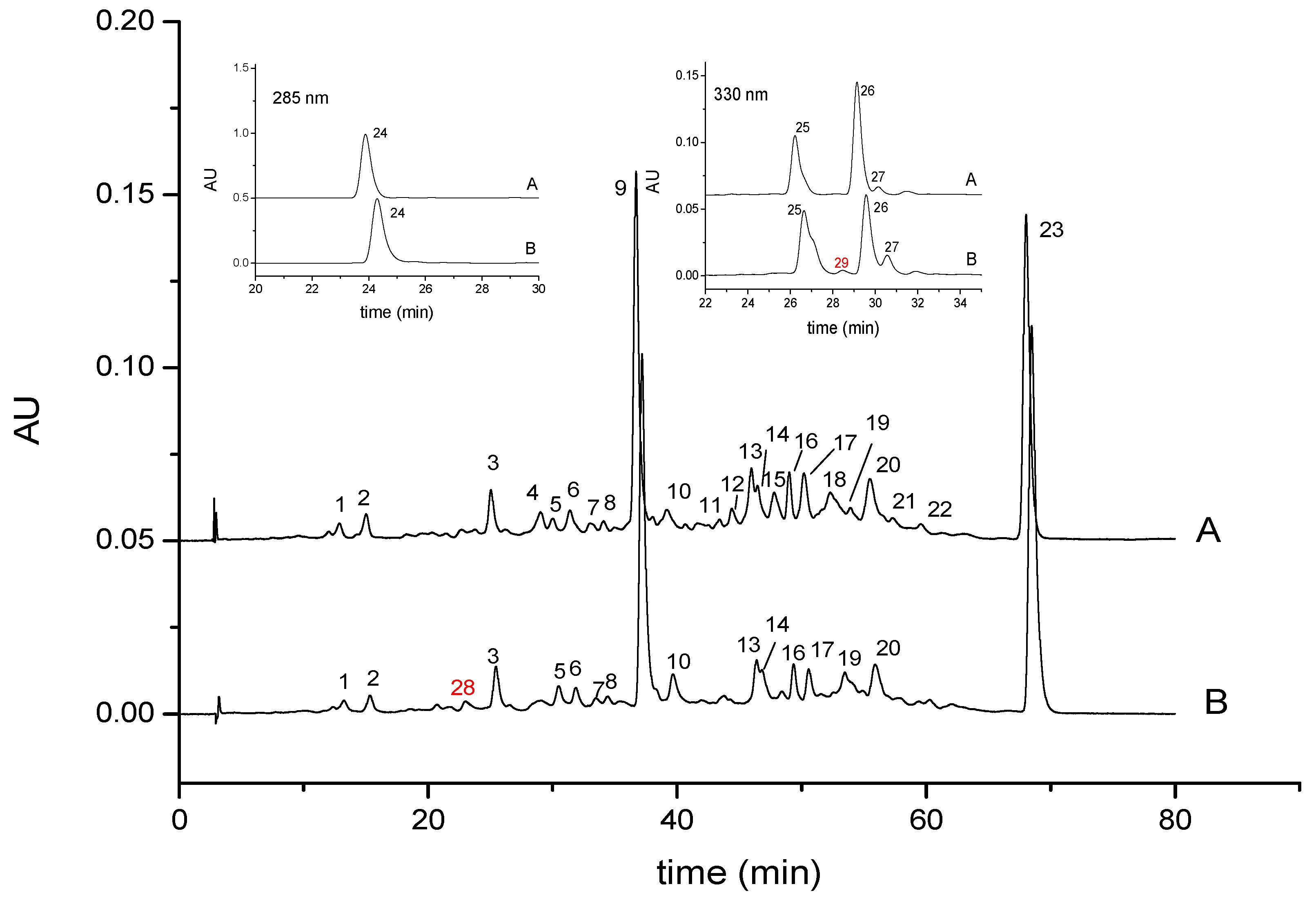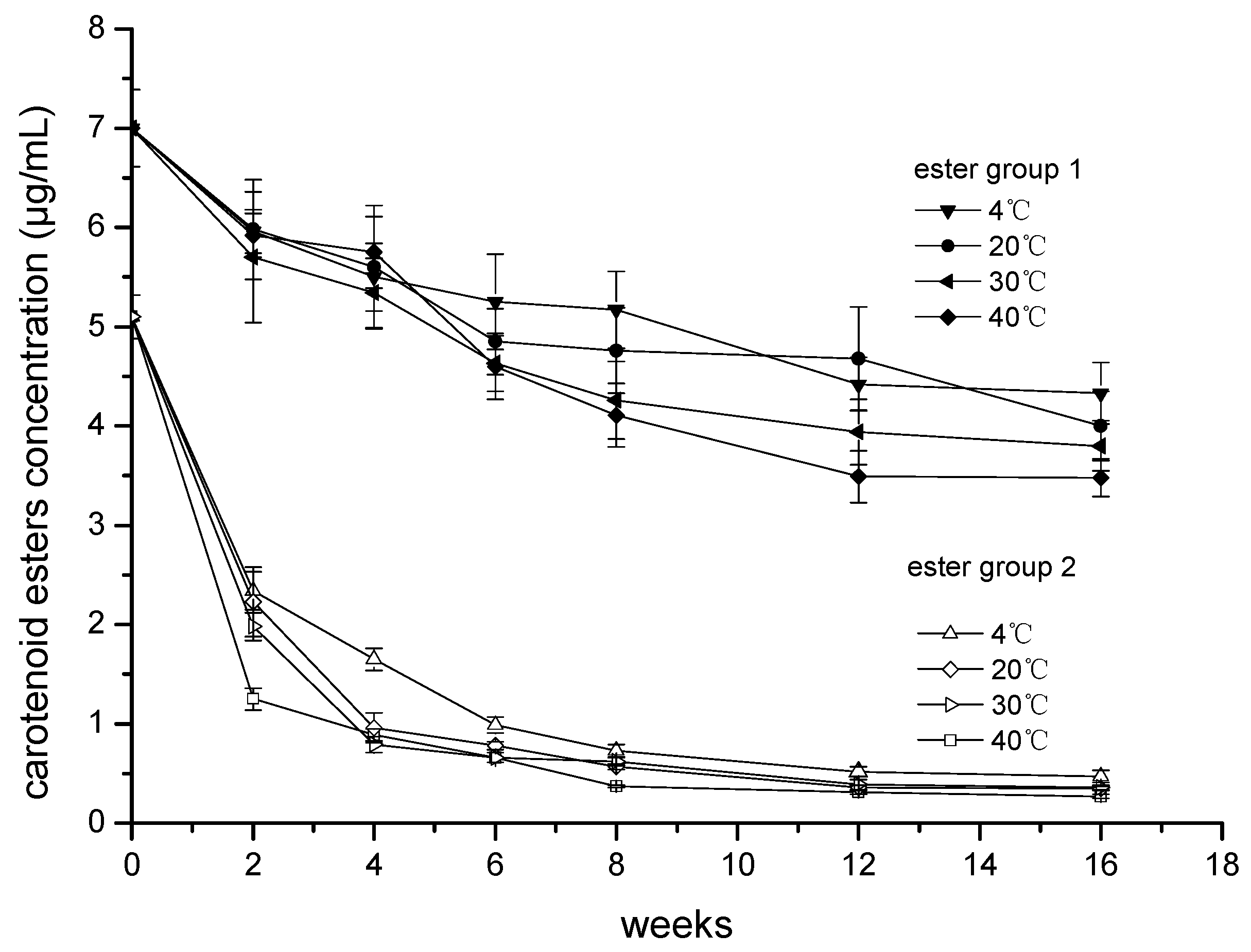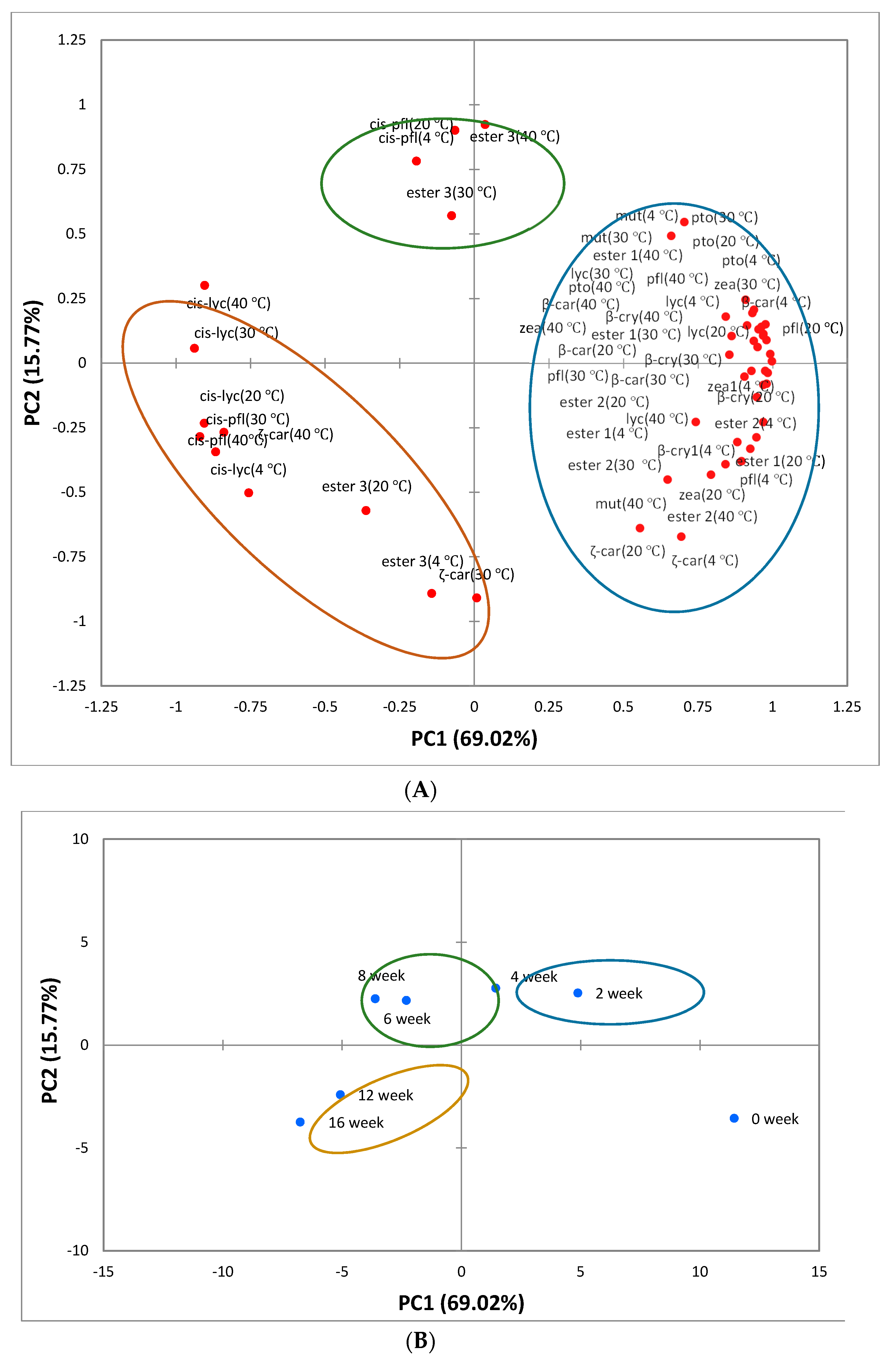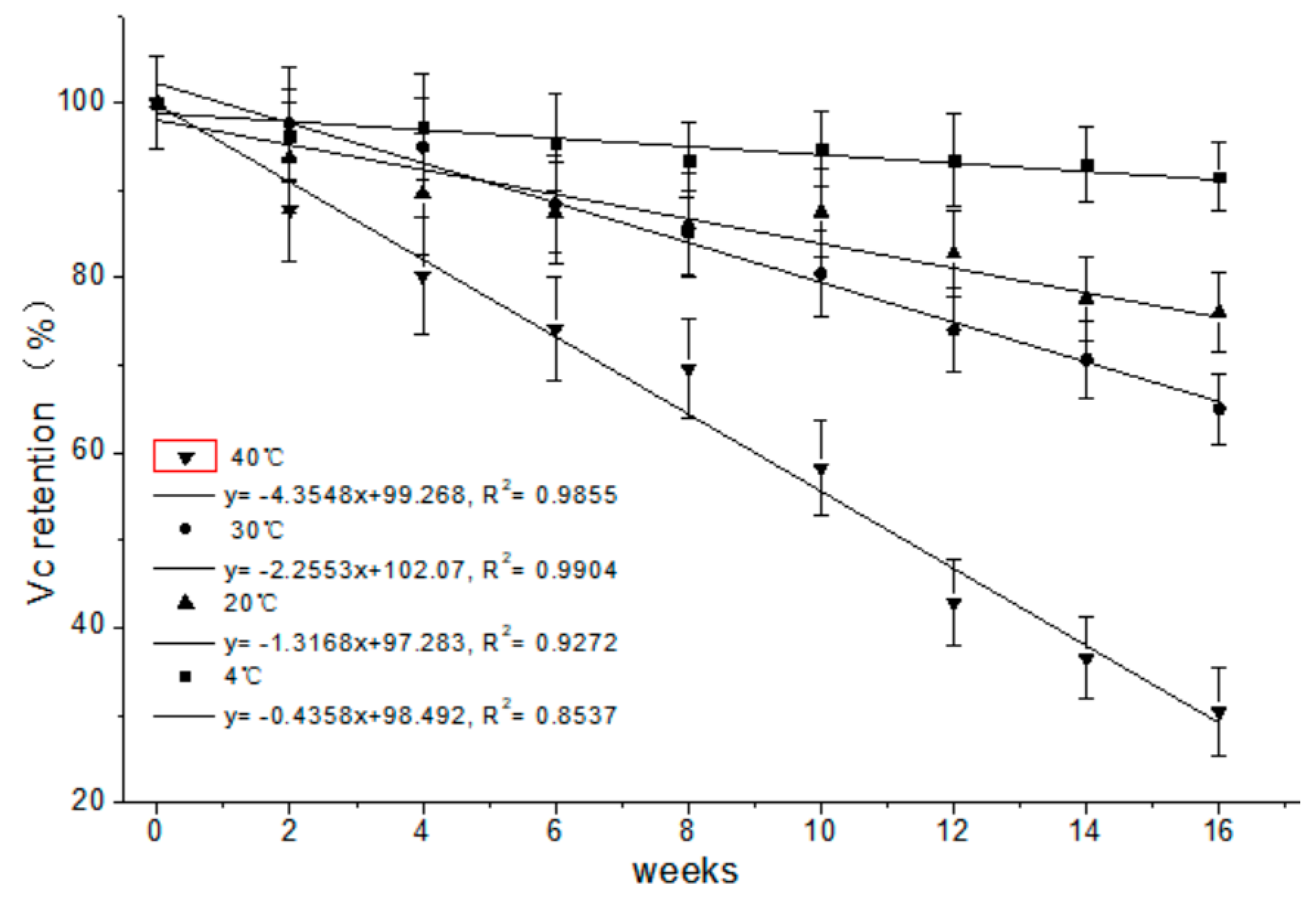Stability of Flavonoid, Carotenoid, Soluble Sugar and Vitamin C in ‘Cara Cara’ Juice during Storage
Abstract
1. Introduction
2. Materials and Methods
2.1. Sample Preparation
2.2. Chemicals and Reagents
2.3. Extraction of Carotenoid from ‘Cara Cara’ Juice
2.4. Extraction of Flavonoid from ‘Cara Cara’ Juice
2.5. Antioxidant Assays
2.6. Analysis of Carotenoids and Flavonoids in ‘Cara Cara’ Juice
2.7. Ascorbic Acid Measurement
2.8. Sugar Measurement
2.9. Statistical Analysis
3. Results and Discussion
3.1. Changes of Flavonoids in ’Cara Cara’ Juice
3.2. The Changes of Carotenoids in ‘Cara Cara’ Juice
3.2.1. Carotenoid Composition
3.2.2. Carotenoid Degradation
3.2.3. PCA Analysis
3.3. The Changes of Soluble Sugars in ‘Cara Cara’ Juice
3.4. The Changes of Vitamin C in ‘Cara Cara’ Juice
3.5. The Changes of Antioxidants in ‘Cara Cara’ Juice
4. Conclusions
Supplementary Materials
Author Contributions
Funding
Acknowledgments
Conflicts of Interest
References
- Wibowo, S.; Grauwet, T.; Santiago, J.S.; Tomic, J.; Vervoort, L.; Hendrickx, M.; Van Loey, A. Quality changes of pasteurised orange juice during storage: A kinetic study of specific parameters and their relation to colour instability. Food Chem. 2015, 187, 140–151. [Google Scholar] [CrossRef] [PubMed]
- Ghanim, H.; Sia, C.L.; Upadhyay, M.; Korzeniewski, K.; Viswanathan, P.; Abuaysheh, S.; Mohanty, P.; Dandona, P. Orange juice neutralizes the proinflammatory effect of a high-fat, high-carbohydrate meal and prevents endotoxin increase and Toll-like receptor expression. Am. J. Clin. Nutr. 2010, 91, 940–949. [Google Scholar] [CrossRef] [PubMed]
- Aschoff, J.K.; Kaufmann, S.; Kalkan, O.; Neidhart, S.; Carle, R.; Schweiggert, R.M. In Vitro Bioaccessibility of Carotenoids, Flavonoids, and Vitamin C from Differently Processed Oranges and Orange Juices (Citrus sinensis (L.) Osbeck). J. Agric. Food Chem. 2015, 63, 578–587. [Google Scholar] [CrossRef] [PubMed]
- Du, J.; Cullen, J.J.; Buettner, G.R. Ascorbic acid: Chemistry, biology and the treatment of cancer. Biochim. Biophys. Acta Rev. Cancer 2012, 1826, 443–457. [Google Scholar] [CrossRef]
- Abuajah, C.I.; Ogbonna, A.C.; Osuji, C.M. Functional components and medicinal properties of food: A review. J. Food Sci. Technol. 2015, 52, 2522–2529. [Google Scholar] [CrossRef] [PubMed]
- Lee, H.S. Characterization of Carotenoids in Juice of Red Navel Orange (Cara Cara). J. Agric. Food Chem. 2001, 49, 2563–2568. [Google Scholar] [CrossRef] [PubMed]
- Lu, Q.; Huang, X.; Lv, S.; Pan, S. Carotenoid profiling of red navel orange “Cara Cara” harvested from five regions in China. Food Chem. 2017, 232, 788–798. [Google Scholar] [CrossRef] [PubMed]
- Rapisarda, P.; Bianco, M.L.; Pannuzzo, P.; Timpanaro, N. Effect of cold storage on vitamin C, phenolics and antioxidant activity of five orange genotypes (Citrus sinensis (L.) Osbeck). Postharvest Biol. Technol. 2008, 49, 348–354. [Google Scholar] [CrossRef]
- Klimczak, I.; Małecka, M.; Szlachta, M.; Gliszczyńska-Świgło, A. Effect of storage on the content of polyphenols, vitamin C and the antioxidant activity of orange juices. J. Food Compos. Anal. 2007, 20, 313–322. [Google Scholar] [CrossRef]
- Lu, Q.; Lv, S.; Peng, Y.; Zhu, C.; Pan, S. Characterization of phenolics and antioxidant abilities of red navel orange “Cara Cara” harvested from five regions of China. Int. J. Food Prop. 2018, 21, 1107–1116. [Google Scholar] [CrossRef]
- Brasili, E.; Chaves, D.F.S.; Xavier, A.A.O.; Mercadante, A.Z.; Hassimotto, N.M.A.; Lajolo, F.M. Effect of Pasteurization on Flavonoids and Carotenoids in Citrus sinensis (L.) Osbeck cv. ‘Cara Cara’ and ‘Bahia’ Juices. J. Agric. Food Chem. 2017, 65, 1371–1377. [Google Scholar] [CrossRef] [PubMed]
- Wibowo, S.; Vervoort, L.; Tomic, J.; Santiago, J.S.; Lemmens, L.; Panozzo, A.; Grauwet, T.; Hendrickx, M.; Van Loey, A. Colour and carotenoid changes of pasteurised orange juice during storage. Food Chem. 2015, 171, 330–340. [Google Scholar] [CrossRef] [PubMed]
- Mezzomo, N.; Ferreira, S.R.S. Carotenoids Functionality, Sources, and Processing by Supercritical Technology: A Review. J. Chem. 2016, 2016, 16. [Google Scholar] [CrossRef]
- Plaza, L.; Sánchez-Moreno, C.; De Ancos, B.; Elez-Martínez, P.; Martín-Belloso, O.; Cano, M.P. Carotenoid and flavanone content during refrigerated storage of orange juice processed by high-pressure, pulsed electric fields and low pasteurization. LWT Food Sci. Technol. 2011, 44, 834–839. [Google Scholar] [CrossRef]
- Lu, Q.; Peng, Y.; Zhu, C.; Pan, S. Effect of thermal treatment on carotenoids, flavonoids and ascorbic acid in juice of orange cv. Cara Cara. Food Chem. 2018, 265, 39–48. [Google Scholar] [CrossRef] [PubMed]
- Vallverdú-Queralt, A.; Arranz, S.; Casals-Ribes, I.; Lamuela-Raventós, R.M. Stability of the Phenolic and Carotenoid Profile of Gazpachos during Storage. J. Agric. Food Chem. 2012, 60, 1981–1988. [Google Scholar] [CrossRef] [PubMed]
- Vallverdú-Queralt, A.; Medina-Remón, A.; Andres-Lacueva, C.; Lamuela-Raventos, R.M. Changes in phenolic profile and antioxidant activity during production of diced tomatoes. Food Chem. 2011, 126, 1700–1707. [Google Scholar] [CrossRef] [PubMed]
- Stinco, C.M.; Fernández-Vázquez, R.; Escudero-Gilete, M.L.; Heredia, F.J.; Meléndez-Martínez, A.J.; Vicario, I.M. Effect of Orange Juice’s Processing on the Color, Particle Size, and Bioaccessibility of Carotenoids. J. Agric. Food Chem. 2012, 60, 1447–1455. [Google Scholar] [CrossRef]
- Lee, H.S.; Nagy, S. Quality Changes and Nonenzymic Browning Intermediates in Grapefruit Juice During Storage. J. Food Sci. 1988, 53, 168–172. [Google Scholar] [CrossRef]
- Mohamed Ahmed, M.V.O.; Bouna, Z.E.O.; Mohamed Lemine, F.M.; Djeh, T.K.O.; Mokhtar, T.; Mohamed Salem, A.O. Use of multivariate analysis to assess phenotypic diversity of date palm (Phoenix dactylifera L.) cultivars. Sci. Hortic. 2011, 127, 367–371. [Google Scholar] [CrossRef]
- Dhuique-Mayer, C.; Caris-Veyrat, C.; Ollitrault, P.; Curk, F.; Amiot, M.-J. Varietal and Interspecific Influence on Micronutrient Contents in Citrus from the Mediterranean Area. J. Agric. Food Chem. 2005, 53, 2140–2145. [Google Scholar] [CrossRef] [PubMed]
- Persic, M.; Mikulic-Petkovsek, M.; Slatnar, A.; Veberic, R. Chemical composition of apple fruit, juice and pomace and the correlation between phenolic content, enzymatic activity and browning. LWT Food Sci. Technol. 2017, 82, 23–31. [Google Scholar] [CrossRef]
- Dhuique-Mayer, C.; Tbatou, M.; Carail, M.; Caris-Veyrat, C.; Dornier, M.; Amiot, M.J. Thermal Degradation of Antioxidant Micronutrients in Citrus Juice: Kinetics and Newly Formed Compounds. J. Agric. Food Chem. 2007, 55, 4209–4216. [Google Scholar] [CrossRef] [PubMed]
- Chen, P.X.; Tang, Y.; Zhang, B.; Liu, R.; Marcone, M.F.; Li, X.; Tsao, R. 5-Hydroxymethyl-2-furfural and Derivatives Formed during Acid Hydrolysis of Conjugated and Bound Phenolics in Plant Foods and the Effects on Phenolic Content and Antioxidant Capacity. J. Agric. Food Chem. 2014, 62, 4754–4761. [Google Scholar] [CrossRef] [PubMed]
- Meléndez-Martínez, A.J.; Britton, G.; Vicario, I.M.; Heredia, F.J. The complex carotenoid pattern of orange juices from concentrate. Food Chem. 2008, 109, 546–553. [Google Scholar] [CrossRef]
- Hadjal, T.; Dhuique-Mayer, C.; Madani, K.; Dornier, M.; Achir, N. Thermal degradation kinetics of xanthophylls from blood orange in model and real food systems. Food Chem. 2013, 138, 2442–2450. [Google Scholar] [CrossRef]
- Cooperstone, J.L.; Francis, D.M.; Schwartz, S.J. Thermal processing differentially affects lycopene and other carotenoids in cis-lycopene containing, tangerine tomatoes. Food Chem. 2016, 210, 466–472. [Google Scholar] [CrossRef] [PubMed]
- Nguyen, M.; Francis, D.; Schwartz, S. Thermal isomerisation susceptibility of carotenoids in different tomato varieties. J. Sci. Food Agric. 2001, 81, 910–917. [Google Scholar] [CrossRef]
- Zepka, L.Q.; Mercadante, A.Z. Degradation compounds of carotenoids formed during heating of a simulated cashew apple juice. Food Chem. 2009, 117, 28–34. [Google Scholar] [CrossRef]
- Cortés, C.; Torregrosa, F.; Esteve, M.J.; Frígola, A. Carotenoid Profile Modification during Refrigerated Storage in Untreated and Pasteurized Orange Juice and Orange Juice Treated with High-Intensity Pulsed Electric Fields. J. Agric. Food Chem. 2006, 54, 6247–6254. [Google Scholar] [CrossRef] [PubMed]
- Akhavan, I.; Wrolstad, R.E. Variation of sugars and acids during ripening of pears and in the production and storage of pear concentrate. J. Food Sci. 1980, 45, 499–501. [Google Scholar] [CrossRef]
- Tiwari, B.K.; O’Donnell, C.P.; Muthukumarappan, K.; Cullen, P.J. Ascorbic acid degradation kinetics of sonicated orange juice during storage and comparison with thermally pasteurised juice. LWT Food Sci. Technol. 2009, 42, 700–704. [Google Scholar] [CrossRef]
- Burdurlu, H.S.; Koca, N.; Karadeniz, F. Degradation of vitamin C in citrus juice concentrates during storage. J. Food Eng. 2006, 74, 211–216. [Google Scholar] [CrossRef]
- Choi, M.H.; Kim, G.H.; Lee, H.S. Effects of ascorbic acid retention on juice color and pigment stability in blood orange (Citrus sinensis) juice during refrigerated storage. Food Res. Int. 2002, 35, 753–759. [Google Scholar] [CrossRef]
- Wu, X.; Beecher, G.R.; Holden, J.M.; Haytowitz, D.B.; Gebhardt, S.E.; Prior, R.L. Lipophilic and Hydrophilic Antioxidant Capacities of Common Foods in the United States. J. Agric. Food Chem. 2004, 52, 4026–4037. [Google Scholar] [CrossRef] [PubMed]
- Miao, J.; Li, X.; Zhao, C.; Gao, X.; Wang, Y.; Gao, W. Active compounds, antioxidant activity and α-glucosidase inhibitory activity of different varieties of Chaenomeles fruits. Food Chem. 2018, 248, 330–339. [Google Scholar] [CrossRef] [PubMed]




| Weeks | Apigenin-6,8-di-C-Glucoside | Narirutin-4′-O-Glucoside | Narirutin | Hesperidin | Didymin | Total Flavonoid Index |
|---|---|---|---|---|---|---|
| 4 °C | ||||||
| 0 | 30.37 ± 2.47 a | 30.43 ± 1.69 a | 140.62 ± 6.47 a | 620.22 ± 22.86 a | 76.15 ± 3.24 a | 897.79 ± 36.73 a |
| 4 | 26.46 ± 0.48 a | 27.41 ± 1.93 a | 137.64 ± 12.29 a | 618.98 ± 29.43 a | 76.45 ± 2.67 a | 886.94 ± 46.80 a |
| 8 | 27.48 ± 1.36 a | 26.77 ± 2.38 a | 136.84 ± 13.91 a | 601.63 ± 16.38 a | 76.16 ± 5.33 a | 868.88 ± 39.39 a |
| 12 | 25.49 ± 1.56 a | 25.93 ± 2.58 a | 134.51 ± 6.17 a | 583.72 ± 5.90 a | 74.34 ± 3.85 a | 843.99 ± 20.06 a |
| 16 | 25.04 ± 0.47 a | 25.52 ± 1.42 a | 129.25 ± 4.35 a | 567.65 ± 13.95 a | 72.91 ± 1.34 a | 820.37 ± 21.53 a |
| 20 °C | ||||||
| 0 | 30.37 ± 2.47 a | 30.43 ± 1.69 a | 140.62 ± 6.47 a | 620.22 ± 22.86 a | 76.15 ± 3.24 a | 897.79 ± 36.73 a |
| 4 | 25.63 ± 2.35 ab | 26.86 ± 3.25 ab | 136.82 ± 4.57 a | 614.16 ± 8.56 ab | 75.28 ± 4.47 a | 878.75 ± 23.20 a |
| 8 | 25.35 ± 1.30 ab | 24.66 ± 0.92 ab | 133.32 ± 1.82 a | 592.5 ± 17.68 ab | 72.73 ± 2.45 a | 848.56 ± 24.17 a |
| 12 | 23.37 ± 0.53 b | 24.65 ± 0.62 ab | 125.89 ± 10.60 a | 574.42 ± 10.99 ab | 74.45 ± 1.34 a | 822.78 ± 24.08 a |
| 16 | 21.25 ± 1.24 b | 21.77 ± 1.45 b | 126.78 ± 5.32 a | 556.75 ± 12.03 b | 71.42 ± 1.38 a | 797.95 ± 21.42 a |
| 30 °C | ||||||
| 0 | 30.37 ± 2.47 a | 30.43 ± 1.69 a | 140.62 ± 6.47 a | 620.22 ± 22.86 a | 76.15 ± 3.24 a | 897.79 ± 36.73 a |
| 4 | 27.33 ± 3.03 a | 26.35 ± 1.65 ab | 133.14 ± 6.59 a | 603.28 ± 17.21 ab | 74.15 ± 1.27 a | 864.25 ± 29.75 a |
| 8 | 26.25 ± 1.73 a | 27.06 ± 1.25 ab | 128.52 ± 12.45 a | 569.28 ± 8.79 ab | 73.10 ± 5.83 a | 824.21 ± 30.05 a |
| 12 | 23.71 ± 0.66 a | 22.91 ± 0.92 b | 121.33 ± 5.08 a | 567.69 ± 10.58 ab | 73.92 ± 0.75 a | 809.56 ± 17.99 a |
| 16 | 22.35 ± 2.62 a | 23.26 ± 2.98 b | 122.57 ± 9.82 a | 550.59 ± 16.56 b | 70.70 ± 3.23 a | 789.47 ± 35.21 a |
| 40 °C | ||||||
| 0 | 30.37 ± 2.47 a | 30.43 ± 1.69 a | 140.62 ± 6.47 a | 620.22 ± 22.86 a | 76.15 ± 3.24 a | 897.79 ± 36.73 a |
| 4 | 24.63 ± 1.45 ab | 26.19 ± 1.55 ab | 131.68 ± 10.37 a | 594.84 ± 14.22 ab | 74.07 ± 4.63 a | 851.41 ± 32.22 a |
| 8 | 25.48 ± 0.93 ab | 26.58 ± 1.12 ab | 132.44 ± 4.75 a | 579.33 ± 15.21 ab | 72.25 ± 2.24 a | 836.08 ± 24.25 a |
| 12 | 23.36 ± 1.23 b | 24.88 ± 1.69 ab | 130.66 ± 8.46 a | 570.12 ± 11.13 ab | 73.33 ± 1.68 a | 822.35 ± 24.19 a |
| 16 | 23.59 ± 2.43 ab | 24.09 ± 1.35 b | 127.59 ± 10.68 a | 552.17 ± 12.54 b | 71.29 ± 3.36 a | 798.73 ± 30.36 a |
| Weeks | Fructose | Glucose | Sucrose | Total |
|---|---|---|---|---|
| 4 °C | ||||
| 0 | 6.96 ± 0.17 a | 15.15 ± 0.90 a | 23.22 ± 1.85 a | 45.33 ± 2.92 a |
| 2 | 6.95 ± 0.31 a | 15.09 ± 0.30 a | 23.16 ± 1.25 a | 45.21 ± 1.86 a |
| 4 | 6.90 ± 0.42 a | 14.92 ± 0.28 a | 23.52 ± 1.36 a | 45.40 ± 2.06 a |
| 6 | 7.02 ± 0.36 a | 15.36 ± 0.44 a | 23.04 ± 1.33 a | 45.36 ± 2.13 a |
| 8 | 6.94 ± 0.55 a | 15.08 ± 0.54 a | 22.89 ± 0.83 a | 44.93 ± 1.92 a |
| 10 | 7.11 ± 0.43 a | 15.58 ± 0.65 a | 22.68 ± 1.42 a | 45.22 ± 2.50 a |
| 12 | 6.75 ± 0.56 a | 14.98 ± 0.36 a | 22.74 ± 1.88 a | 44.68 ± 2.80 a |
| 14 | 6.48 ± 0.38 a | 15.97 ± 0.45 a | 22.88 ± 1.76 a | 45.81 ± 2.59 a |
| 16 | 6.54 ± 0.25 a | 15.72 ± 0.23 a | 22.02 ± 1.42 a | 44.70 ± 1.90 a |
| 20 °C | ||||
| 0 | 6.96 ± 0.17 a | 15.15 ± 0.90 a | 23.22 ± 1.85 a | 45.33 ± 2.92 a |
| 2 | 7.03 ± 0.12 a | 15.13 ± 0.14 a | 23.94 ± 1.67 a | 46.03 ± 1.93 a |
| 4 | 6.92 ± 0.42 a | 15.29 ± 0.64 a | 23.38 ± 1.79 a | 45.63 ± 2.85 a |
| 6 | 6.68 ± 0.88 a | 15.23 ± 0.92 a | 23.06 ± 1.15 a | 45.25 ± 2.95 a |
| 8 | 6.94 ± 0.37 a | 15.11 ± 0.78 a | 23.55 ± 1.84 a | 45.62 ± 2.99 a |
| 10 | 6.56 ± 0.21 a | 15.64 ± 0.44 a | 23.44 ± 1.38 a | 46.04 ± 2.03 a |
| 12 | 6.62 ± 0.54 a | 15.79 ± 0.59 a | 23.16 ± 1.47 a | 45.91 ± 2.60 a |
| 14 | 7.08 ± 0.52 a | 16.07 ± 0.84 a | 22.43 ± 1.15 a | 45.46 ± 2.51 a |
| 16 | 6.84 ± 0.35 a | 16.13 ± 0.72 a | 21.50 ± 1.55 a | 44.59 ± 2.62 a |
| 30 °C | ||||
| 0 | 6.96 ± 0.17 a | 15.15 ± 0.90 a | 23.22 ± 1.85 ab | 45.33 ± 2.92 a |
| 2 | 6.75 ± 0.29 a | 15.16 ± 0.85 a | 23.60 ± 1.13 a | 45.72 ± 2.27 a |
| 4 | 6.79 ± 0.50 a | 15.71 ± 0.78 a | 22.12 ± 2.05 ab | 44.79 ± 3.33 a |
| 6 | 7.14 ± 0.61 a | 15.85 ± 0.69 a | 21.81 ± 1.28 ab | 44.62 ± 2.58 a |
| 8 | 7.18 ± 0.65 a | 16.00 ± 1.36 a | 21.03 ± 1.11 ab | 43.99 ± 3.12 a |
| 10 | 7.15 ± 1.85 a | 16.20 ± 0.46 a | 20.37 ± 0.64 ab | 43.53 ± 2.95 a |
| 12 | 6.88 ± 0.47 a | 16.68 ± 0.96 a | 19.54 ± 1.57 ab | 43.18 ± 3.0 a |
| 14 | 7.17 ± 0.28 a | 16.85 ± 1.27 a | 19.00 ± 1.42 ab | 42.81 ± 2.97 a |
| 16 | 7.18 ± 0.17 a | 16.05 ± 0.47 a | 18.09 ± 1.54 b | 41.10 ± 2.18 a |
| 40 °C | ||||
| 0 | 6.96 ± 0.17 d | 15.15 ± 0.90 c | 23.22 ± 1.85 a | 45.33 ± 2.92 a |
| 2 | 8.10 ± 0.24 cd | 17.32 ± 1.37 c | 20.87 ± 1.59 a | 45.15 ± 3.2 a |
| 4 | 8.69 ± 0.22 bc | 18.10 ± 1.04 cb | 16.97 ± 1.21 b | 42.03 ± 2.47 ab |
| 6 | 9.05 ± 0.38 abc | 21.89 ± 1.53 ab | 9.77 ± 0.24 c | 38.62 ± 2.15 abc |
| 8 | 9.04 ± 0.81 abc | 22.43 ± 1.38 a | 5.82 ± 0.30 d | 35.21 ± 2.49 bc |
| 10 | 10.01 ± 0.66 ab | 22.70 ± 0.79 a | 4.06 ± 0.11 de | 33.72 ± 1.56 bc |
| 12 | 9.34 ± 0.75 abc | 23.43 ± 1.50 a | 2.77 ± 0.14 de | 33.16 ± 2.39 c |
| 14 | 9.45 ± 0.38 abc | 23.42 ± 1.03 a | 1.59 ± 0.06 e | 31.88 ± 1.47 c |
| 16 | 10.78 ± 0.38 a | 24.01 ± 1.04 a | nd | 30.97 ± 1.42 c |
| Weeks | Hydrophilic ABTS 1 | Hydrophilic DPPH 2 | Lipophilic ABTS | Lipophilic DPPH |
|---|---|---|---|---|
| 4 °C | ||||
| 0 | 6.42 ± 0.44 a | 2.14 ± 0.06 a | 0.88 ± 0.03 a | 0.76 ± 0.02 a |
| 4 | 6.23 ± 0.12 a | 2.09 ± 0.06 a | 0.81 ± 0.02 ab | 0.75 ± 0.03 a |
| 8 | 5.89 ± 0.31 a | 2.1 ± 0.06 a | 0.87 ± 0.02 a | 0.74 ± 0.05 a |
| 12 | 5.71 ± 0.21 a | 2.04 ± 0.06 a | 0.80 ± 0.03 ab | 0.74 ± 0.04 a |
| 16 | 5.54 ± 0.24 a | 1.94 ± 0.05 a | 0.77 ± 0.05 ab | 0.72 ± 0.02 a |
| 20 °C | ||||
| 0 | 6.42 ± 0.44 a | 2.14 ± 0.06 a | 0.88 ± 0.03 a | 0.76 ± 0.02 a |
| 4 | 5.84 ± 0.31 a | 1.92 ± 0.05 b | 0.82 ± 0.04 a | 0.73 ± 0.06 a |
| 8 | 5.89 ± 0.32 a | 1.86 ± 0.05 b | 0.87 ± 0.06 a | 0.69 ± 0.02 a |
| 12 | 5.81 ± 0.24 a | 1.82 ± 0.04 b | 0.76 ± 0.03 a | 0.67 ± 0.03 a |
| 16 | 5.48 ± 0.21 a | 1.64 ± 0.03 c | 0.75 ± 0.04 a | 0.67 ± 0.04 a |
| 30 °C | ||||
| 0 | 6.42 ± 0.44 a | 2.14 ± 0.06 a | 0.88 ± 0.03 a | 0.76 ± 0.02 a |
| 4 | 6.19 ± 0.27 a | 1.84 ± 0.05 b | 0.83 ± 0.06 a | 0.74 ± 0.03 ab |
| 8 | 6.06 ± 0.32 a | 1.82 ± 0.03 b | 0.82 ± 0.04 a | 0.66 ± 0.05 ab |
| 12 | 5.76 ± 0.28 a | 1.64 ± 0.04 c | 0.76 ± 0.05 a | 0.68 ± 0.03 ab |
| 16 | 5.53 ± 0.34 a | 1.56 ± 0.05 c | 0.73 ± 0.03 a | 0.62 ± 0.02 b |
| 40 °C | ||||
| 0 | 6.42 ± 0.44 a | 2.14 ± 0.06 a | 0.88 ± 0.03 a | 0.76 ± 0.02 a |
| 4 | 6.35 ± 0.31 cd | 1.96 ± 0.06 ab | 0.86 ± 0.03 ab | 0.72 ± 0.01 ab |
| 8 | 6.26 ± 0.32 bc | 1.80 ± 0.05 bc | 0.79 ± 0.02 ab | 0.73 ± 0.03 ab |
| 12 | 6.18 ± 0.24 abc | 1.72 ± 0.03 c | 0.75 ± 0.05 b | 0.64 ± 0.05 ab |
| 16 | 5.91 ± 0.26 abc | 1.61 ± 0.06 c | 0.74 ± 0.03 b | 0.63 ± 0.04 b |
| Hydrophilic ABTS+ | Hydrophilic DPPH | |
|---|---|---|
| apigenin-6,8-di-C-glucoside | 0.752 ** | 0.857 ** |
| narirutin-4’-O-glucoside | 0.808 ** | 0.870 ** |
| narirutin | 0.702 ** | 0.901 ** |
| hesperidin | 0.699 ** | 0.874 ** |
| didymin | 0.608 ** | 0.882 ** |
| total flavonoid index | 0.742 ** | 0.910** |
| Lipophilic ABTS+ | Lipophilic DPPH | |
|---|---|---|
| mutatoxanthin | 0.420 | 0.391 |
| zeaxanthin | 0.724 ** | 0.634 ** |
| β-cryptoxanthin | 0.704 ** | 0.604 ** |
| ζ-carotene | −0.178 | −0.195 |
| β-carotene | 0.640 ** | 0.558 * |
| 13- or 15-cis-lycopene | −0.655 ** | −0.666 ** |
| lycopene | 0.652 ** | 0.600 ** |
| phytoene | 0.698 ** | 0.619 ** |
| phytofluene | 0.760 ** | 0.848 ** |
| cis-phytofluene | −0.629 ** | −0.764 ** |
| ester group 1 | 0.865 ** | 0.799 ** |
| ester group 2 | 0.703 ** | 0.645 ** |
| ester group 3 | −0.225 | −0.293 |
| total carotenoid index | 0.732 ** | 0.664 ** |
© 2019 by the authors. Licensee MDPI, Basel, Switzerland. This article is an open access article distributed under the terms and conditions of the Creative Commons Attribution (CC BY) license (http://creativecommons.org/licenses/by/4.0/).
Share and Cite
Lu, Q.; Li, L.; Xue, S.; Yang, D.; Wang, S. Stability of Flavonoid, Carotenoid, Soluble Sugar and Vitamin C in ‘Cara Cara’ Juice during Storage. Foods 2019, 8, 417. https://doi.org/10.3390/foods8090417
Lu Q, Li L, Xue S, Yang D, Wang S. Stability of Flavonoid, Carotenoid, Soluble Sugar and Vitamin C in ‘Cara Cara’ Juice during Storage. Foods. 2019; 8(9):417. https://doi.org/10.3390/foods8090417
Chicago/Turabian StyleLu, Qi, Lu Li, Shujin Xue, De Yang, and Shaohua Wang. 2019. "Stability of Flavonoid, Carotenoid, Soluble Sugar and Vitamin C in ‘Cara Cara’ Juice during Storage" Foods 8, no. 9: 417. https://doi.org/10.3390/foods8090417
APA StyleLu, Q., Li, L., Xue, S., Yang, D., & Wang, S. (2019). Stability of Flavonoid, Carotenoid, Soluble Sugar and Vitamin C in ‘Cara Cara’ Juice during Storage. Foods, 8(9), 417. https://doi.org/10.3390/foods8090417




